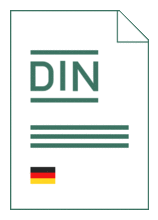
Standard [CURRENT]
DIN EN 10249-2:2024-09
Cold formed steel sheet piles - Part 2: Tolerances on dimensions and shape; German version EN 10249-2:2024
- German title
- Kaltgeformte Spundbohlen aus Stahl - Teil 2: Grenzabmaße und Formtoleranzen; Deutsche Fassung EN 10249-2:2024
- Publication date
- 2024-09
- Original language
- German
- Pages
- 13
- Publication date
- 2024-09
- Original language
- German
- Pages
- 13
- DOI
- https://dx.doi.org/10.31030/3526299
Product information on this site:
Quick delivery via download or delivery service
All transactions are encrypted
Overview
One area of application for sheet piles is permanent use as a building element in hydraulic engineering for quay walls, lock walls, canals, breakwaters, and harbor basins. Another area of application is the temporary securing of excavation pits, where the sheet piles can be removed again after completion of the construction work and backfilling of the excavation pit. Steel sheet piles can be manufactured to be practically watertight. It is possible to work in an excavation pit enclosed by sheet piles (sheet pile casing) even below the water table. The bottom of the excavation pit is sealed either by naturally dense soil or a concrete slab (underwater concrete base). The Romans already used sheet piles, although only wooden sheet piles were used until the beginning of the 20th century. The steel sheet pile in its current form was invented around 1880 by the Bremen state architect Tryggve Larssen. The steel sheet pile consisted of a U-shaped rolled profile with a riveted connecting clamp, the lock. They were manufactured at the Union steelworks in Dortmund from 1902, and when they proved successful, Larssen was granted a patent in 1904. In 1902 the first sheet pile was driven into the ground as a shore revetment in the Hohentorshafen in Bremen. Between 1914 and 1921 the sheet pile profile with interlock was developed, and since then the sheet piles have been connected by interlocking tongue and groove joints during driving, creating a continuous wall. This means that during driving (or other types of installation such as vibration or shaking), each sheet is guided through the interlock of the last piling installed and connected to it by means of positive-fitting. Since then, sheet piles have been rolled from a single piece. Today, sheet pile profiles are differentiated according to the rolling process and their shape. Hot-rolled sheet piles are standardized in DIN EN 10248 and have a U-shape or a Z- or H-shape. Flat profiles are also available. Cold-rolled sheet piles are standardized in DIN EN 10249. The most common profiles are available in lengths from approximately 6 m to 30 m. Sheet piles are made from steels for steel construction. NA 021-00-04-05 UA 'Spundbohlen' ('Sheet piling') at DIN is responsible for this standard.
Content
ICS
DOI
This document replaces DIN EN 10249-2:1995-08 .

